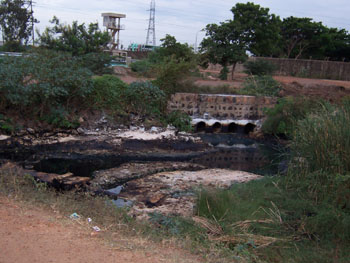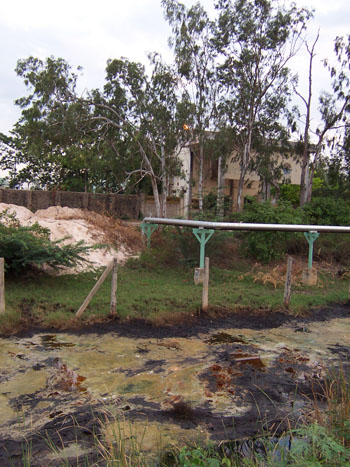PRESS RELEASE
4 January, 2008.CHENNAI — At least
26 toxic volatile organic chemicals and sulphur gases including carcinogenic benzene and bromomethane were found in an air sample taken in Manali several hours after the gas leak of December 4-5, 2007. Of the 26 chemicals, the 11 chemicals that were reliably identified
include Hydrogen Sulphide, Carbon Disulphide, Bromomethane, Methyl Ethyl Ketone, Benzene, Toluene, n-Hexane, Ethylbenzene, m,p-Xylenes, o-Xylene, and n-Nonane. Benzene, hydrogen sulphide, carbon disulphide and bromomethane were above safe limits. Barring bromomethane, all other chemicals are known to be part of refinery emissions. Benzene and hydrogen sulphide was 36 times and 33 times higher than safe levels prescribed by the United States Environmental Protection Agency respectively. The sample was analysed for 89 chemicals in Columbia Analytical Services, California.

Benzene is
causes childhood leukemia (blood cancer). Hydrogen sulphide, a gas with a rotten egg smell, is a powerful neurotoxin that affects the brain, and reduces the IQ of growing children. Both chemicals target children particularly.
“Given that the sample was taken after and not during the gas leak, levels of toxic gases during the gas leak are likely to have been many times higher than what was found,” said Dr. Rakhal Gaitonde, a public health specialist. “Contrary to claims by the TNPCB that the leaked gases were harmless, the air sample results indicate that even under normal circumstances, the air in Manali is a threat to public health.”

Subsequent
to the release, the TNPCB admitted that venting of hydrocarbons is routine and that the incident of early December was caused by adverse weather conditions. Releasing toxic gases to the environment is not in line with best industry practices worldwide. Ironically, CPCL has received environmental and safety awards every year from 2000 onwards, including from the Central Pollution Control Board, TERI, LoyolaCollege, CII and Greentech Foundation.
Manali, and the areas of North Chennai, are home to most of the city’s poor and working classes. Long-standing complaints of pollution in the area have not been taken seriously. Regulatory authorities have exposed a total lack of capacity to curb pollution or deal with hazardous situations. Evacuation during a major emergency is impossible in North Chennai owing to the congested streets and the high density of hazardous industries.
The December incident highlighted the inability of the district administration, police, TNPCB and the health services departments to understand and deal with the public health crisis caused by the gas leak.
Under these circumstances, a recent move by the Secretary, Department of Environment, to convene an interdepartmental Crisis Cell for Chemical Accidents is a welcome and much-needed initiative.
The sample was taken by Chennai-based Community Environmental Monitoring. Analytical costs were paid by Global Community Monitor in California.
Community Environmental Monitoring. Contact: Nityanand Jayaraman 9444082401
42A, 1st Floor, 5th Avenue, Besant Nagar, Chennai 600 090
KEY AIR TOXIC SUBSTANCES EMITTED FROM OIL REFINERIES:
Ammonia –
AT, CT
Benzene – C, BD, R, CT – ***
Biphenyl – BD, CT – ***
1,3-Butadiene – C, BD, R, CT – ***
Carbon disulfide (CS2) – AT, CT – ***
Carbonyl sulfide (COS) – AT, CT – ***
Cumene – CT, N – ***
Cyclohexane – AT, CT
Diethanolamine (DEA) – C – ***
Dioxin (TCDD) – C, BD, R, CT – ***
Ethylene – CT
Ethylbenzene – BD, R, CT – ***
Hydrogen sulfide (H2S) – N, AT, CT
Mercury (Hg) – N – ***
Methyl Ethyl Ketone (MEK) – AT, CT – ***
Methyl Tertiary Butyl Ether (MTBE) – C, AT, CT – ***
Naphthalene – AT, CT – ***
Phenol – BD, AT – ***
Propylene – AT, CT
Styrene – C, M, CT – ***
Sulfur trioxide (SO3) – AT, CT
Sulfuric acid (H2SO4) – AT, CT – ***
1,2,4-trimethylbenzene – AT, CT – ***
Toluene – BD, R – ***
Xylenes – BD, R, CT – ***
AC = ACUTE TOXIN
BD = DEVELOPMENTAL TOXIN (causes birth defects)
C = CARCINOGEN
CT = CHRONIC TOXIN
M = HERITABLE MUTAGEN (causes genetic changes to DNA or genes)
N = NEUROTOXIN
R = REPRODUCTIVE TOXIN
***HAP = HAZARDOUS AIR POLLUTANT (list of 188 HAPs is from Title III of the
1990 Federal Clean Air Act Amendments signed into law November 15, 1990)
Analyses of results from the sample taken downwind of CPCL in Manali, North Madras
Date of Sampling: 5 December 2007
Time of Sampling: 4:20 pm
Location: Across the road from CPCL compound wall at MGR Nagar, West of CPCL
Wind direction: Northeast to Southwest.
Description of sampling conditions and location: Gusty wind. Faint to strong smell of bitumen/tar. Local
residents reported that the smell, at the time of sampling, was at normal
background levels, and that it had been more than four hours since the smell
was intense.
Results:
- 11 chemicals detected: Hydrogen Sulphide, Carbon Disulphide, Bromomethane, Methyl Ethyl Ketone,
Benzene, Toluene, n-Hexane, Ethylbenzene, m,p-Xylenes, o-Xylene, n-Nonane
- 4 out of 11 chemicals above known environmental standards:
– Benzene, a known carcinogen, 36 times above limits
– Hydrogen Sulphide, a potent neurotoxin, 33 times above limits
– Carbon Disulphide, also a neurotoxin, 7.6 times above limits
– Bromomethane, a carcinogen, 1.4 times above limits
- Out of the 11 chemicals found, 10 target the eyes and the Central Nervous System, 9 target the respiratory system and skin, 5 target the kidneys, 4 target the liver, 3 target the blood, 2 target the Peripheral Nervous System, Cardio Vascular System and
the gastrointestinal tract and 1 chemical targets the reproductive system and bone marrow.
|
S No
|
Chemical found
|
Levels detected (ug/m3)
|
Health based Screening levels
|
Number of times exceed the
|
Odour
|
Health Effects
|
Target Organs
|
Carcinogen
|
|
1.
|
Hydrogen Sulphide
|
33
|
1.00 (US EPA Region 6 Screening
|
33
|
A strong odour of rotten eggs
|
Irritation of eyes, respiratory
|
Eyes, respiratory system, central
|
No
|
|
2.
|
Carbon Disulphide
|
23
|
3 (Texas Long-Term Screening Levels)
|
7.67
|
A sweet ether-like odour
|
Dizziness, headache, poor sleep,
|
central nervous system, peripheral
|
No
|
|
3.
|
Bromomethane
|
7.50
|
5.20 (US EPA Region 6 Screening
|
1.44
|
A chloroform-like odour at high
|
Irritation eyes, skin, respiratory system; Central Nervous
|
Eyes, skin, respiratory system, liver, kidneys, Cardiovascular
|
Yes
Known
|
|
4.
|
2-Butanone
(Methyl
|
110
|
1000 (EPA Region 6 Screening
|
—
|
A moderately sharp, fragrant,
|
Irritation eyes, skin, nose;
|
Eyes, skin, respiratory system,
|
No
|
|
5.
|
n-Hexane
|
17
|
210 (EPA Region 6 Screening Level)
|
—
|
A gasoline-like odour
|
Irritation eyes, nose; nausea,
|
Eyes, skin, respiratory system,
|
No
|
|
6.
|
Benzene
|
9.09
|
0.250 (EPA Region 6 Screening
|
36.36
|
An aromatic odour
|
Irritation eyes, skin, nose,
|
Eyes, skin, respiratory system,
|
Yes
Cancer Site >[leukaemia]
|
|
7.
|
Toluene
|
66
|
400 (EPA Region 6 Screening Level)
|
—
|
A sweet, pungent, benzene-like
|
Irritation eyes, nose; weakness,
|
Eyes, skin, respiratory system,
|
No
|
|
8.
|
Ethylbenzene
|
6.70
|
1100 (EPA Region 6 Screening
|
—
|
An aromatic odour.
|
Irritation eyes, skin, mucous
|
Eyes, skin, respiratory system,
|
No
|
|
9.
|
m,p- Xylenes
|
14.0
|
—
|
—
|
An aromatic odour.
|
Irritation eyes, skin, nose,
|
Eyes, skin, respiratory system,
|
No
|
|
10.
|
o-Xylene
|
6.0
|
730 (EPA Region 6 Screening Level)
|
—
|
An aromatic odour.
|
Irritation eyes, skin, nose,
|
Eyes, skin, respiratory system,
|
No
|
|
11.
|
N-Nonane
|
22
|
NA
|
NA
|
NA
|
NA
|
NA
|
NA
|
